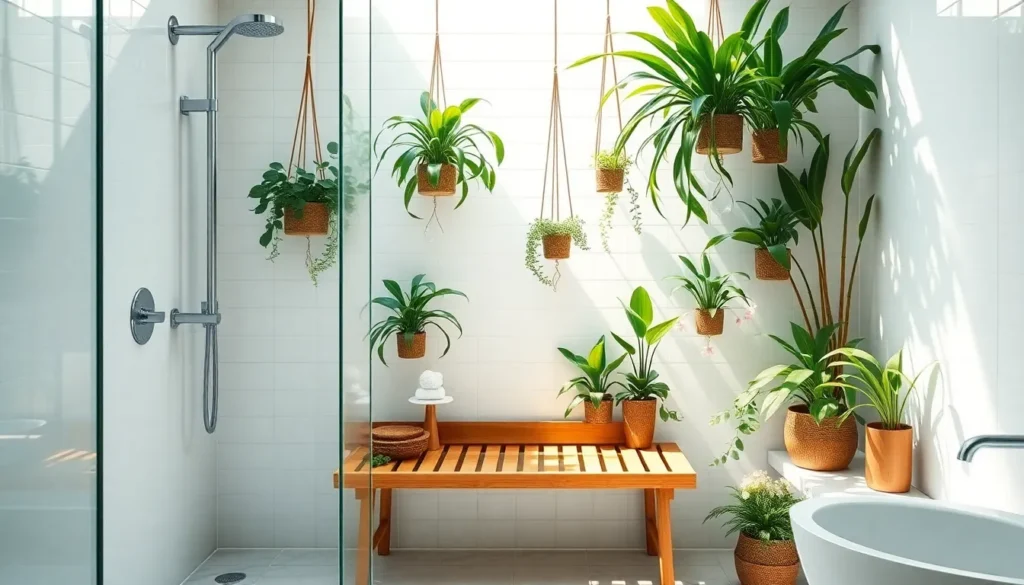We’ve all dreamed of transforming our bathrooms into spa-like sanctuaries, and there’s no better way to achieve this than by incorporating lush greenery into your shower space. Plants in showers aren’t just a trending design choice – they’re a game-changer that brings natural beauty, improved air quality, and a calming atmosphere to your daily routine.
The steamy, humid environment of your shower creates the perfect tropical paradise for many plant varieties. From cascading pothos that drape elegantly from shower caddies to stunning air plants that thrive without soil, we’ll show you how to select the right flora for your unique space and lighting conditions.
Whether you’re working with a spacious walk-in shower or a compact bathroom, we’ve discovered creative answers that’ll turn your morning routine into a rejuvenating escape. Get ready to discover which plants love humidity, how to display them safely, and the simple maintenance tips that’ll keep your shower garden thriving year-round.
Benefits of Adding Plants to Your Shower Space
Plants in shower spaces offer remarkable advantages that transform ordinary bathrooms into refreshing wellness retreats. We’ll explore how these green additions enhance both function and form in your daily routine.
Improved Air Quality and Humidity Control
Plants naturally purify the air by filtering out common household toxins like formaldehyde and benzene through their leaves and root systems. Spider plants remove up to 95% of formaldehyde from enclosed spaces within 24 hours according to NASA’s Clean Air Study. Peace lilies excel at absorbing ammonia vapors that often accumulate in bathroom environments.
Moisture regulation becomes effortless when plants absorb excess humidity through their foliage and release it gradually. Boston ferns can reduce bathroom humidity levels by 10-15% while maintaining optimal moisture for comfortable breathing. Aloe vera plants store water in their thick leaves and release it slowly to prevent overly dry conditions.
Oxygen production increases significantly during daylight hours as shower plants perform photosynthesis. Snake plants uniquely continue producing oxygen throughout the night, making them ideal for windowless bathrooms. Air plants require no soil and absorb moisture directly from humid shower air while continuously filtering pollutants.
Natural Stress Relief and Spa-Like Atmosphere
Greenery triggers immediate psychological benefits by reducing cortisol levels and lowering blood pressure during daily routines. Studies show that viewing plants for just 3-5 minutes decreases stress hormones by 15-20% compared to sterile environments. Eucalyptus releases aromatic compounds that promote relaxation and clear respiratory passages.
Biophilic design principles activate our innate connection to nature, creating calming sensory experiences in confined spaces. Trailing pothos vines soften harsh bathroom angles while providing gentle movement from steam circulation. Lavender plants offer natural aromatherapy benefits that promote deeper relaxation during evening showers.
Color psychology works powerfully as various green tones reduce anxiety and mental fatigue after long workdays. Deep forest greens from rubber plants create grounding effects, while bright lime hues from nerve plants energize morning routines. Multiple plant varieties provide diverse textures that engage our senses beyond just visual appeal.
Enhanced Aesthetic Appeal and Visual Interest
Living decor elements add ever-changing beauty that changes with seasons and growth patterns unlike static bathroom accessories. Monstera deliciosa develops striking split leaves over time, creating evolving focal points that prevent visual boredom. Cascading string of hearts creates elegant natural curtains when displayed in hanging planters.
Vertical garden installations maximize limited floor space while drawing the eye upward to create illusions of height and spaciousness. Wall-mounted air plant displays transform blank shower walls into living art galleries. Tiered plant stands allow multiple species to coexist while creating layered depth and visual complexity.
Natural texture contrasts complement smooth tile and glass surfaces by introducing organic shapes and varied leaf patterns. Broad-leafed plants like elephant ears provide bold statements against minimalist bathroom designs. Delicate ferns offer intricate details that reward closer inspection during quiet moments.
Best Plant Varieties for Shower Environments
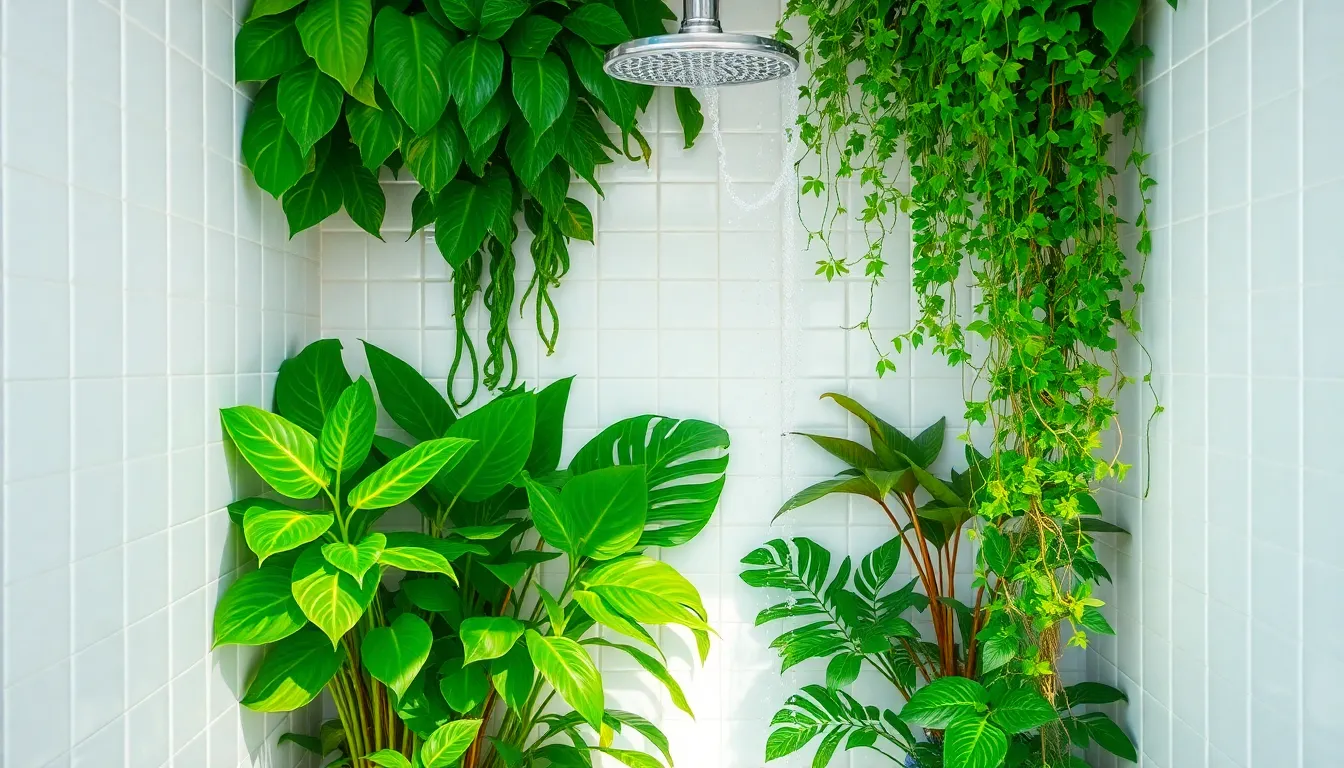
We’ve identified the most effective plant species that transform your shower into a lush oasis while thriving in humid conditions. These carefully selected varieties adapt beautifully to shower environments and create stunning visual displays.
Tropical Plants That Thrive in High Humidity
Pothos (Epipremnum aureum) leads our tropical selection because it flourishes in high humidity environments and tolerates various light levels. Its trailing vines create elegant cascading displays when placed in hanging baskets above your shower space.
Philodendron species perform exceptionally well in humid bathroom conditions while requiring minimal maintenance. These plants adapt to low and medium light conditions, making them perfect for most shower configurations.
Calathea varieties showcase striking foliage patterns that transform your shower into a tropical paradise. Their leaves respond beautifully to the consistent humidity levels found in shower environments.
Boston Fern (Nephrolepis exaltata) brings authentic tropical vibes with its feathery fronds that absolutely love moist atmospheres. This native tropical species thrives in indirect light conditions common in most shower spaces.
Bird’s Nest Fern creates dramatic focal points with its broad, glossy leaves that collect moisture naturally. These plants flourish in warm, humid conditions while adding sophisticated texture to your shower design.
Peace Lily offers both beauty and function by purifying the air while producing elegant white blooms. This tropical beauty thrives in moist environments and adapts well to lower light bathroom settings.
Low-Light Tolerant Species for Windowless Bathrooms
Spider Plant (Chlorophytum comosum) adapts remarkably well to challenging windowless bathroom conditions. Its extreme adaptability allows it to thrive even in low light situations while producing attractive cascading shoots.
English Ivy (Hedera helix) tolerates fluctuating light conditions and varying humidity levels with impressive resilience. This versatile climber works beautifully in showers that lack natural lighting.
Lucky Bamboo (Dracaena sanderiana) grows successfully in low light humid conditions and creates zen-like displays. These plants thrive when placed in water-filled containers, making them perfect for shower shelving.
Air Plants (Tillandsia species) absorb moisture directly from shower steam without requiring soil or complex lighting setups. These fascinating epiphytes attach easily to shower walls or decorative displays.
Staghorn Fern (Platycerium bifurcatum) mounts beautifully on plaques or boards while thriving in humid, indirect light conditions. This epiphytic tropical fern creates stunning living art pieces in darker shower spaces.
Fast-Growing Options for Quick Results
Pothos varieties develop rapidly with trailing vines that quickly fill empty shower spaces. Their fast growth rate means you’ll see dramatic improvements in your shower’s appearance within weeks of installation.
Spider Plant produces new shoots continuously, allowing for quick propagation and expanding displays. These rapid growers create full, lush appearances faster than most other shower suitable plants.
Philodendron species grow steadily under moderate conditions, providing substantial foliage coverage in short timeframes. Their consistent growth patterns make them reliable choices for quickly establishing your shower garden.
Rubber Tree ‘Burgundy’ offers bold tropical foliage that develops quickly in humid bathroom environments. This fast growing variety creates impressive visual impact while adapting well to shower conditions.
Creative Placement Ideas for Shower Plants
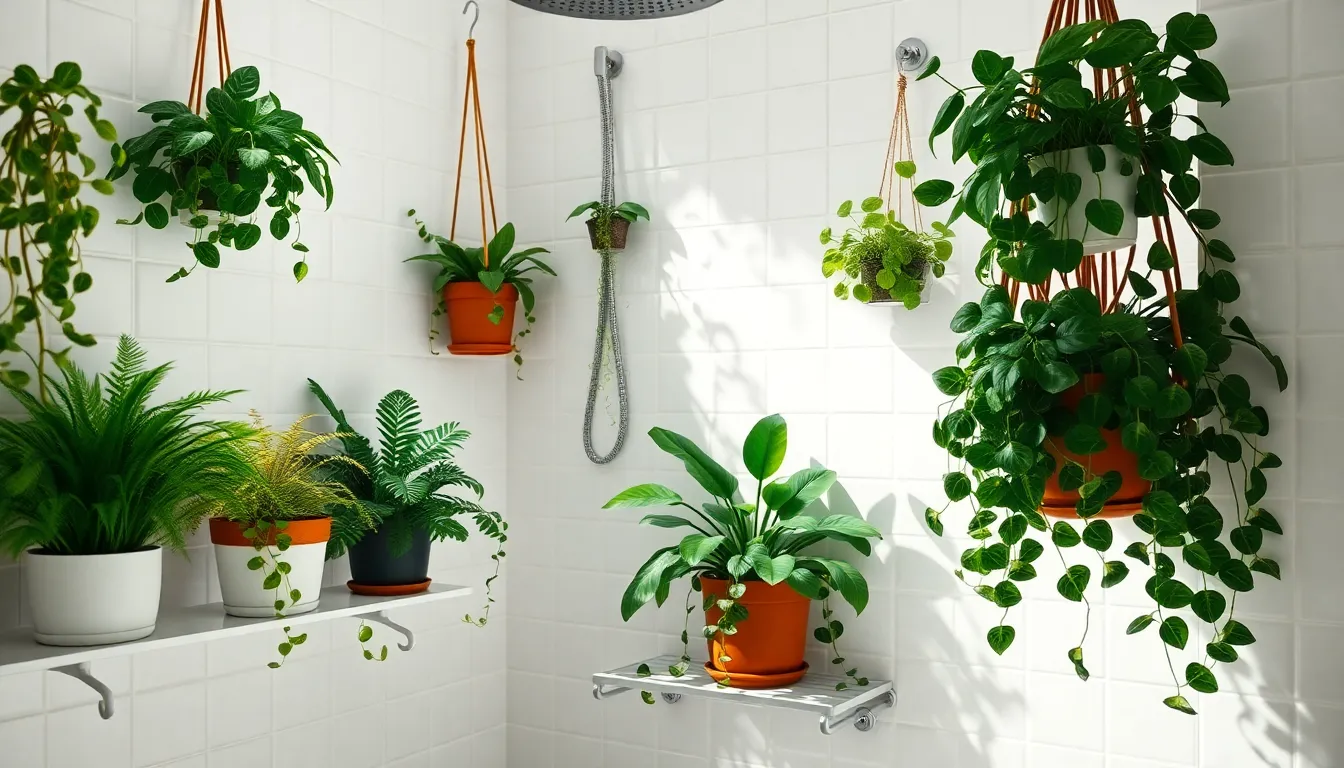
We’ve explored the benefits and best varieties for shower plants, so now let’s jump into the most effective ways to position them in your space. Strategic placement ensures your plants thrive while creating the perfect spa-like atmosphere.
Hanging Planters and Ceiling Installations
Ceiling installations offer the most dramatic visual impact for your shower garden. We recommend using screw eye hooks, J-hooks, or toggle screws to securely hang plants from the ceiling in your shower area. These hardware options provide the sturdy hold needed to support plant weight safely.
Measuring and marking your desired locations comes first before drilling pilot holes for a professional installation. Safety considerations require avoiding placement directly above head height or near fragile fixtures.
Renters can explore drilling-free alternatives like adhesive hooks, suction cup hooks, tension rods, or magnetic hooks for metal surfaces. Plants selected for hanging must handle humidity and occasional water splashes typical of shower environments.
Corner Shelving and Ledge Arrangements
Waterproof corner shelves create perfect platforms for medium-sized plants in compact shower spaces. We suggest installing these shelves using wall anchors or adhesive strips specifically designed for wet environments to prevent corrosion and slipping.
Plant selection for shelf arrangements should focus on species that tolerate high humidity and indirect light, such as ferns, air plants, or pothos. Ceramic or waterproof pots protect against water damage while maintaining aesthetic appeal.
Multiple shelf levels allow for varied plant heights and create visual depth in smaller shower areas. This arrangement works particularly well for displaying collections of smaller plants together.
Floor-Standing Options for Larger Spaces
Spacious showers accommodate larger potted plants positioned strategically on the floor in corners or along edges. We choose plants that thrive in low light and high moisture conditions, such as snake plants or peace lilies, for these floor installations.
Waterproof trays or mats beneath pots catch excess water and protect shower flooring from potential damage. Decorative waterproof planters complement your bathroom design while providing proper drainage.
Floor positioning works best when plants don’t obstruct movement or create safety hazards in the shower space. Large specimens like rubber trees or monstera deliciosa can serve as stunning focal points in oversized shower areas.
Essential Care Tips for Shower Plants
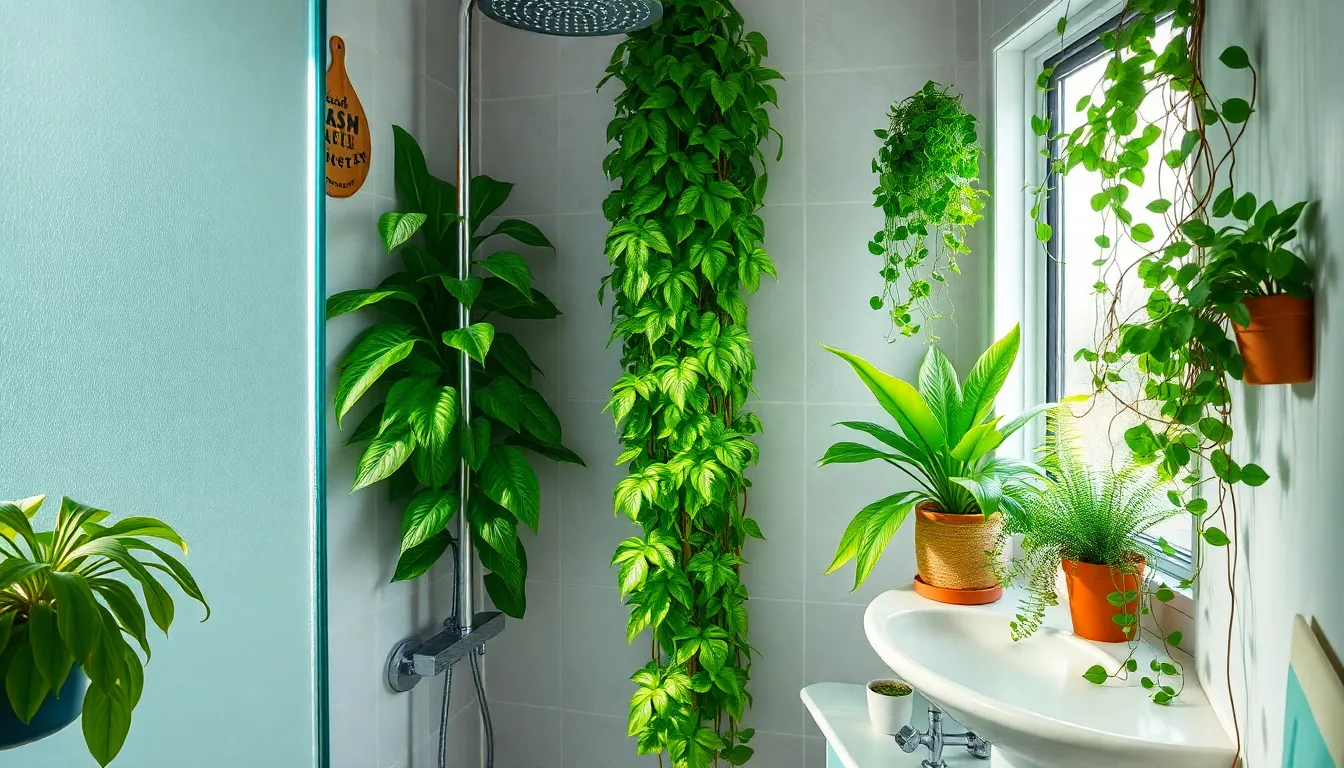
Maintaining plants in shower environments requires understanding the unique challenges and benefits of high humidity and limited lighting conditions. We’ll guide you through essential practices that ensure your shower garden thrives year-round.
Watering Requirements in High-Humidity Environments
Consistent moisture management becomes crucial when caring for plants in naturally humid shower spaces. Plants like pothos and philodendron typically need less frequent watering since they absorb moisture from the humid air around them. We recommend checking the top inch of soil before watering—if it feels moist, wait another day or two.
Drainage proves absolutely essential to prevent root rot in these moisture-rich environments. Always use pots with drainage holes and place saucers underneath to catch excess water. For air plants such as tillandsia, weekly soaking for 20-30 minutes provides adequate hydration without the risk of overwatering.
Water quality matters significantly for shower plants exposed to soap residue and steam. Use filtered or distilled water when possible, especially for sensitive species like calathea and prayer plants that can develop brown leaf tips from chemicals in tap water.
Light Management and Supplemental Lighting
Natural light optimization starts with positioning plants near bathroom windows or skylights whenever available. Ferns and spider plants thrive in the indirect light that typically filters through frosted bathroom glass. We suggest rotating plants weekly to ensure even light exposure on all sides.
Supplemental grow lights become necessary in windowless bathrooms or spaces with minimal natural illumination. LED grow lights work best for shower environments since they’re energy-efficient and produce less heat. Install them 12-18 inches above your plants and run them for 12-14 hours daily to support healthy growth.
Light meters help determine whether your chosen spot provides adequate illumination for exact plant varieties. Most shower-appropriate plants need between 100-500 foot-candles of light. English ivy and pothos tolerate lower light levels, while rubber trees require brighter conditions to maintain their glossy leaves.
Pruning and Maintenance in Wet Conditions
Regular leaf cleaning prevents soap scum and mineral deposits from blocking pores on plant leaves. We recommend wiping leaves with a damp microfiber cloth weekly, paying special attention to plants positioned directly in spray zones. This simple practice maintains healthy foliage and prevents buildup that could hinder photosynthesis.
Pruning schedules should align with each plant’s growth pattern and the humid environment’s tendency to promote faster development. Remove yellowing or damaged leaves immediately to prevent fungal issues that spread quickly in moist conditions. Boston ferns benefit from trimming dead fronds every 2-3 weeks during growing season.
Fertilization needs adjustment in high-humidity environments where nutrients can leach from soil more rapidly. Apply diluted balanced fertilizer every 4-6 weeks during spring and summer, reducing frequency to every 8-10 weeks in winter. Peace lilies and snake plants require minimal feeding, while fast-growing varieties like pothos benefit from monthly applications during active growth periods.
Safety Considerations for Bathroom Plant Displays
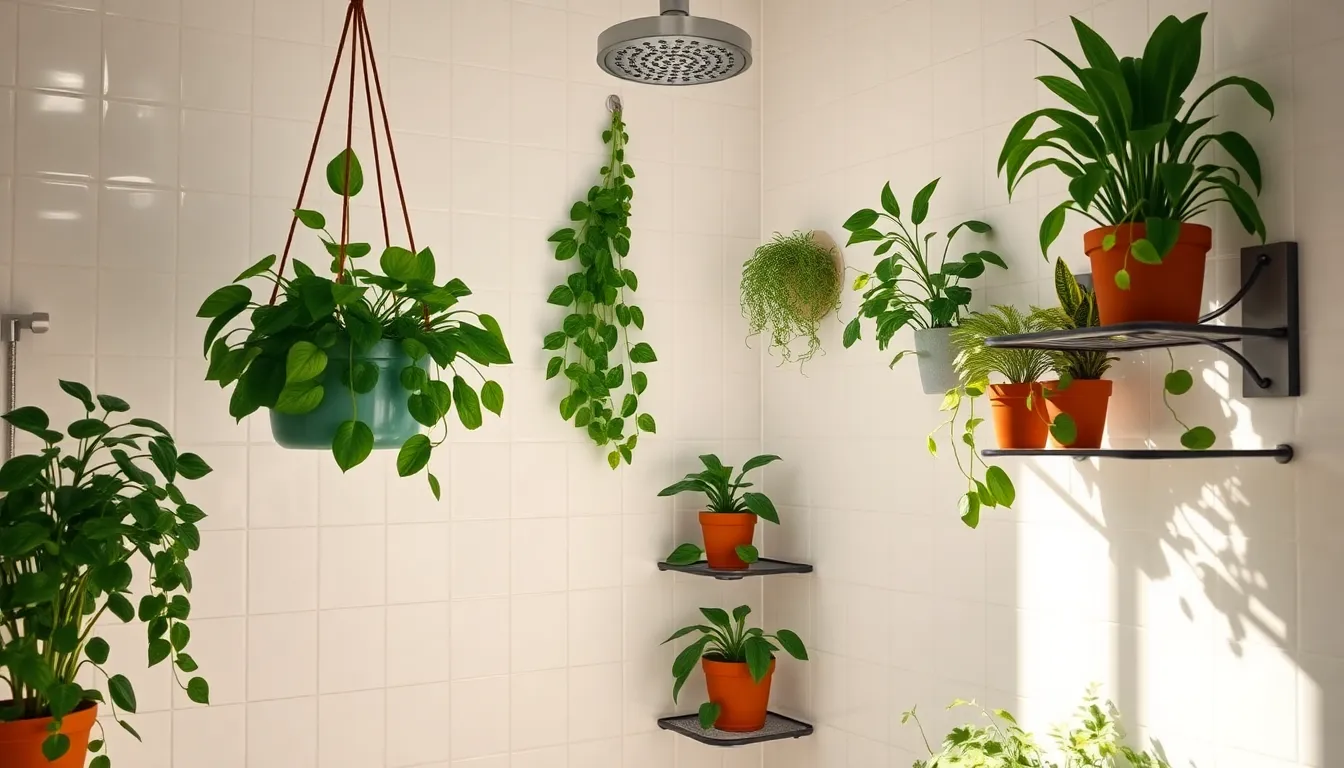
Creating a safe shower plant display requires careful attention to potential hazards in wet environments. We’ll explore essential safety measures to ensure your green sanctuary remains both beautiful and secure.
Non-Slip Surfaces and Secure Mounting
Placing plants on non-slip mats prevents dangerous slips in naturally wet shower environments. Stable shelves provide secure platforms for plant pots without compromising safety. Wall-mounted planters need proper anchoring to withstand humidity and occasional water spray. Secure mounting systems prevent falling plants that could cause injury or property damage.
Hanging installations require heavy-duty hardware designed for bathroom conditions. Ceiling hooks must support both plant weight and moisture exposure over time. We recommend checking mounting stability regularly since bathroom humidity can affect hardware integrity.
Choosing Non-Toxic Plants for Enclosed Spaces
Selecting non-toxic plant varieties protects your family from potential health risks in enclosed bathroom spaces. English Ivy, Boston Fern, Peace Lily, Spider Plant, Pothos, and Philodendron can cause health problems in humid bathroom settings. These plants may attract pests or promote harmful mold growth in shower environments.
Shade-tolerant species that handle humidity and warm temperatures offer safer alternatives. Consulting verified lists of non-toxic indoor plants helps avoid allergic reactions or toxicity issues. We prioritize plants that thrive in bathroom conditions without compromising air quality or safety.
Proper Drainage to Prevent Water Damage
Installing adequate drainage holes in plant pots prevents waterlogging that leads to root rot and dangerous mold growth. Proper drainage systems stop stagnant moisture that harms both plants and human health. Catch trays collect excess water while maintaining airflow around plant containers.
Overwatering combined with natural bathroom humidity creates ideal conditions for harmful mold development. Strategic pot placement allows proper air circulation while preventing water accumulation. We ensure drainage answers protect your bathroom surfaces from water damage while keeping plants healthy.
Stylish Container Options for Shower Plants
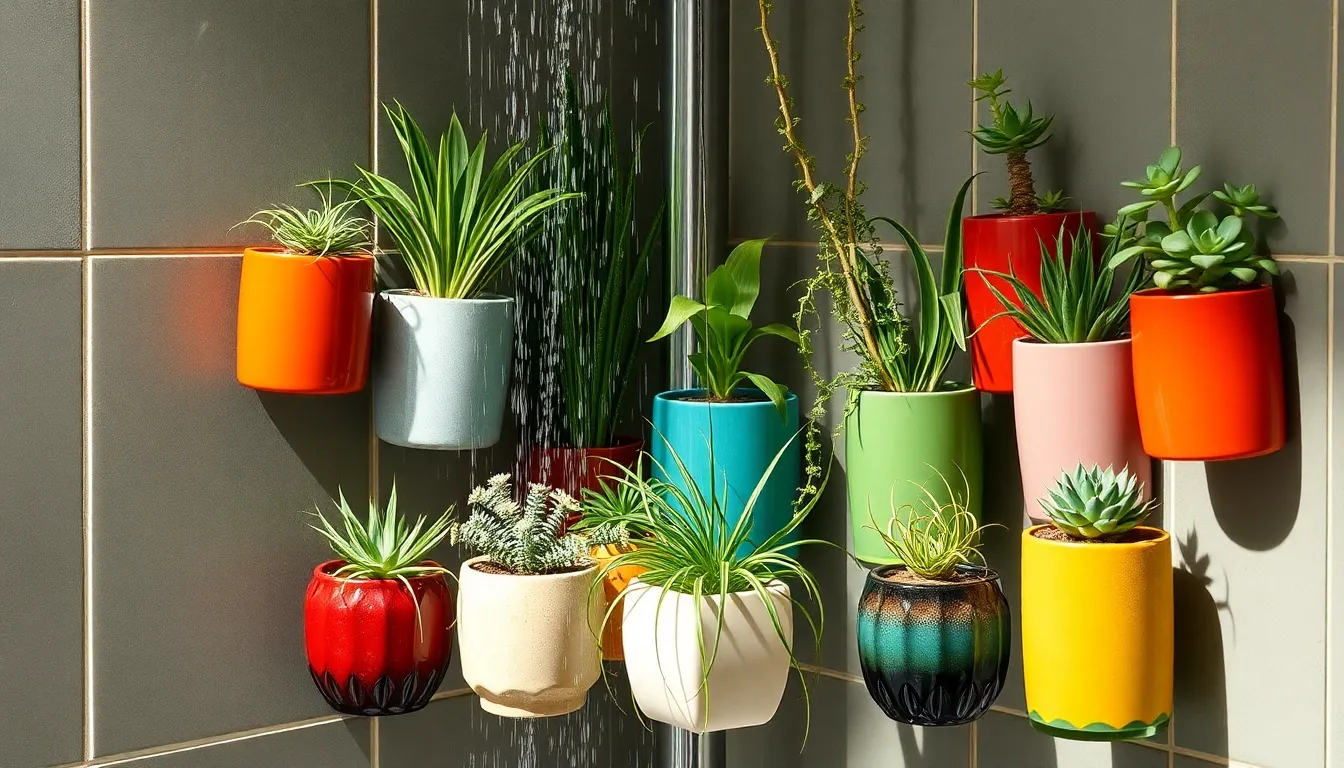
Selecting the right containers transforms your shower plant display from ordinary to extraordinary. We’ll explore waterproof materials, decorative vessels, and creative DIY answers that’ll make your bathroom plants shine.
Waterproof and Rust-Resistant Materials
Ceramic or glazed pots offer the perfect combination of style and durability for shower environments. These containers resist water damage while providing countless design options to match any bathroom aesthetic.
Plastic pots deliver lightweight practicality without sacrificing functionality. We recommend choosing high-quality plastic planters with built-in drainage holes that won’t crack under temperature changes.
Glass vessels create elegant displays that showcase your plants beautifully. Clear glass containers work especially well for air plants and small succulents, allowing you to see root development while maintaining a sophisticated look.
Stainless steel and aluminum containers provide modern appeal with superior rust resistance. Avoid other metal planters that may corrode in humid shower conditions, potentially staining your bathroom surfaces.
Decorative Vessels That Match Your Bathroom Decor
Minimalistic white ceramic pots complement modern bathroom designs perfectly. Clean lines and neutral colors create cohesive visual flow with contemporary fixtures and tiles.
Colorful geometric planters add playful energy to vibrant bathroom spaces. Bold patterns and bright hues can echo your tile work or accent colors for a coordinated appearance.
Natural terracotta containers enhance rustic or earthy bathroom themes beautifully. These porous materials work well with Mediterranean or bohemian design styles while providing excellent drainage.
Textured planters create visual interest by complementing your bathroom’s existing surfaces. Choose containers with finishes that echo your countertops, fixtures, or tile patterns for maximum decorative impact.
DIY Planter Ideas Using Household Items
Repurposed glass jars and mason jars make charming planters for small shower plants. Clean containers thoroughly and add drainage holes or pebbles to prevent root rot in your homemade planters.
Upcycled tin cans create rustic container gardens with minimal investment. Sand rough edges smooth and apply waterproof sealant to prevent rust while maintaining that industrial aesthetic.
Macramé plant hangers crafted from recycled rope or cord add bohemian flair to your shower space. These hanging answers work perfectly for air plants and trailing varieties like pothos.
Converted wooden crates or floating shelves provide platform space for multiple plant displays. Seal wood surfaces with waterproof finish to prevent moisture damage while creating tiered garden arrangements.
Design Themes for Plant-Enhanced Showers
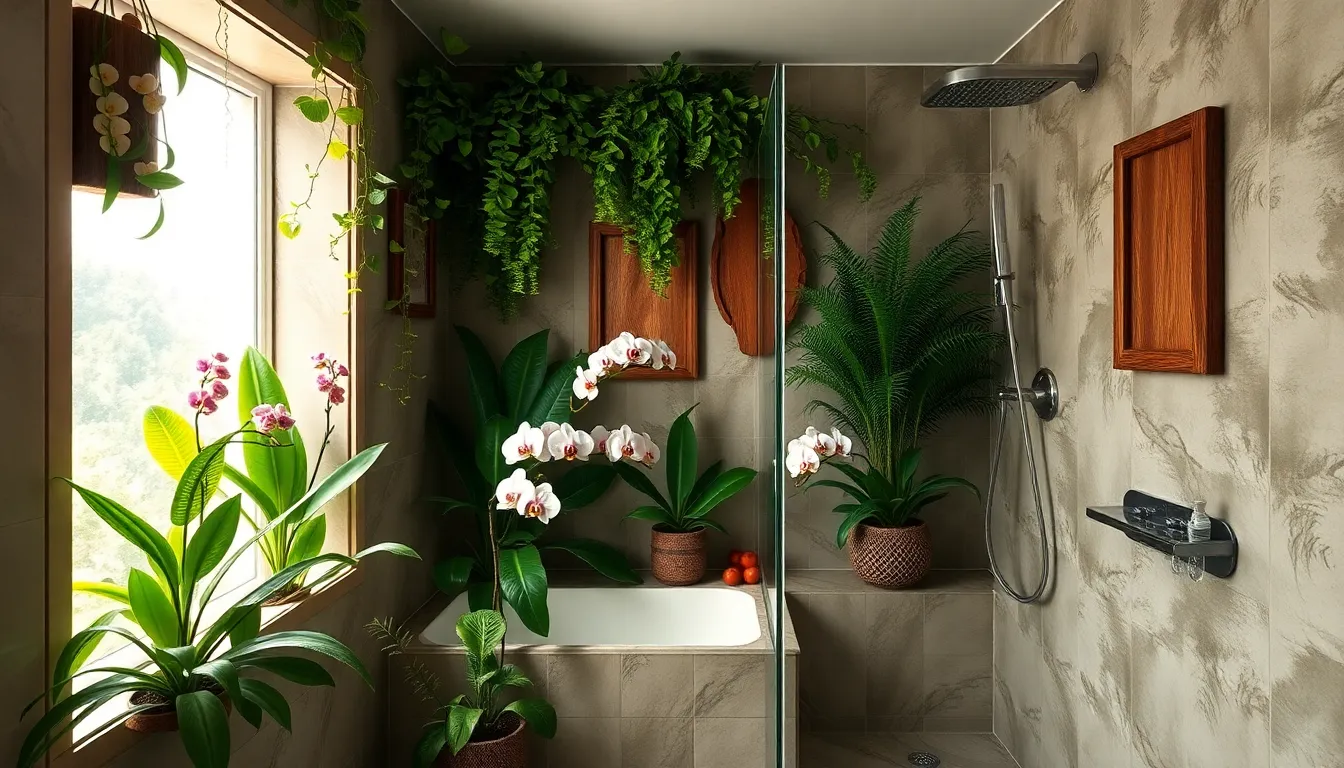
Creating a cohesive aesthetic for your plant-enhanced shower requires choosing the right design theme. We’ll explore three distinct approaches that transform ordinary bathrooms into extraordinary retreats.
Tropical Rainforest Shower Sanctuary
Transform your bathroom into a lush rainforest retreat by incorporating moisture-loving plants that thrive in humid conditions. Ferns serve as the foundation of this design, adapting perfectly to shaded bathroom corners while flourishing in the steam-rich environment. Orchids add sophisticated elegance when positioned near windows where they’ll receive gentle, indirect light throughout the day.
Staghorn ferns create dramatic wall displays when mounted on wooden plaques, mimicking their natural epiphytic growth patterns. We recommend grouping different fern varieties together to achieve maximum visual impact and create layers of cascading greenery.
| Plant Type | Placement | Care Level |
|---|---|---|
| Boston Ferns | Hanging baskets | Low |
| Orchids | Window shelves | Medium |
| Staghorn Ferns | Wall mounts | Medium |
| Bird’s Nest Ferns | Corner stands | Low |
Minimalist Zen Garden Bathroom
Embrace simplicity with clean lines and carefully selected plants that enhance tranquility without overwhelming the space. Lucky bamboo grows exclusively in water-filled vases, making it perfect for creating vertical accents that align with minimalist principles. Air plants require no soil and can be artfully arranged on simple wooden shelves or suspended in glass orbs.
These low-maintenance options focus attention on natural textures while maintaining the serene atmosphere essential to Zen design. We suggest limiting your plant selection to two or three varieties to preserve the minimalist aesthetic.
Bohemian Jungle Bathroom Oasis
Create an eclectic jungle vibe by mixing various plant types with different leaf shapes and growth patterns. Spider plants produce cascading baby plants that add movement and casual charm to the space. Peace lilies contribute both visual appeal and functional air purification benefits.
Aloe vera plants serve dual purposes, providing skincare benefits while adding sculptural interest with their thick, architectural leaves. Dragon plants introduce bold foliage patterns that complement the bohemian style’s embrace of natural diversity.
We recommend arranging plants at different heights using macrame hangers, corner stands, and floating shelves to create a layered jungle effect that feels wild yet intentional.
Maintenance Schedule for Healthy Shower Plants
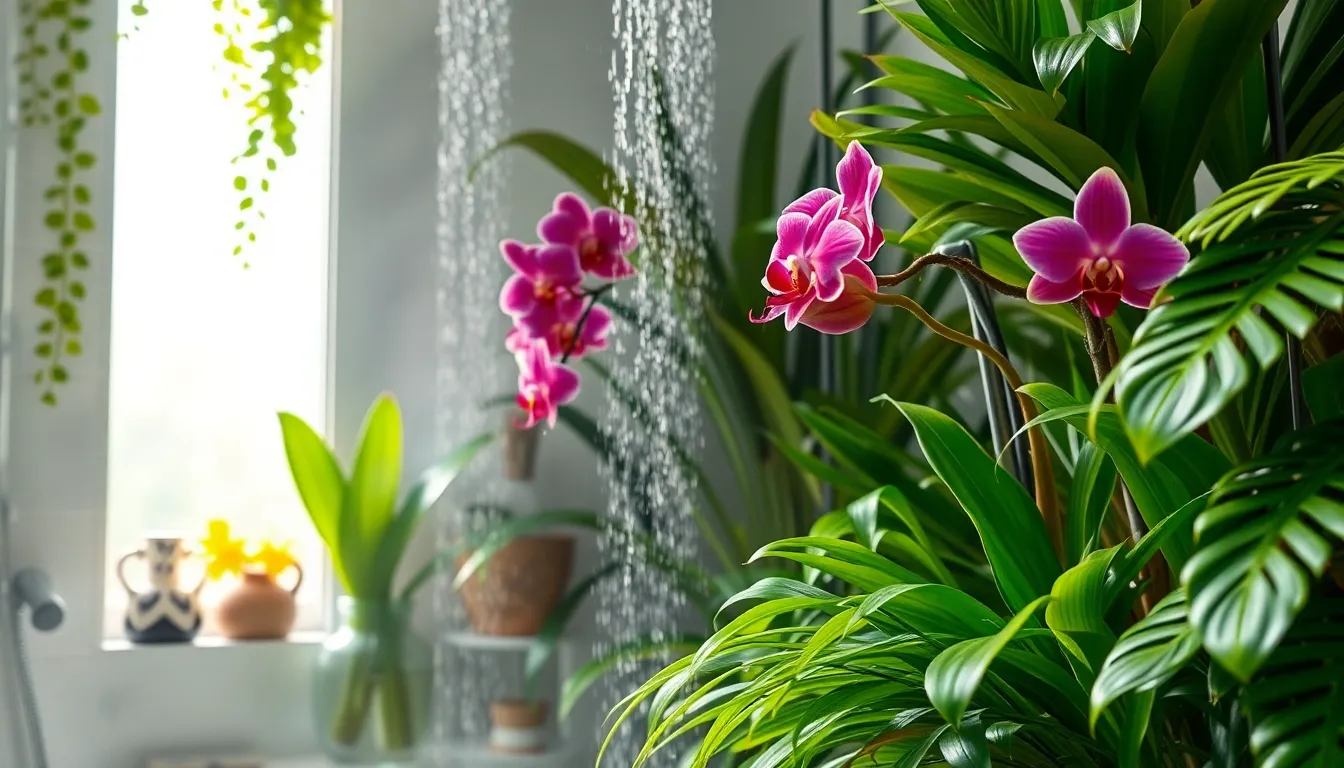
Proper maintenance ensures our shower plants thrive in their humid environment while contributing to our bathroom’s wellness sanctuary. We’ll establish consistent care routines that leverage the natural benefits of shower conditions.
Weekly Care Routines and Inspection
Rotate plants daily between shower space and other locations to provide optimal humidity exposure for moisture-loving species like orchids. We recommend cycling 2-3 plants through the shower area regularly, allowing each plant to benefit from the gentle mist and steam while preventing overexposure.
Filter water whenever possible to protect plants from chlorine and hard water minerals that cause stress. Installing a filtered shower head provides cleaner water that significantly improves plant health outcomes.
Spray underneath leaves gently during routine care to remove dust buildup and prevent pest infestations. Bird’s nest ferns and anthuriums particularly benefit from this gentle cleaning approach that maintains their glossy appearance.
Inspect plants carefully each week for signs of leaf damage or stress, paying special attention to new baby leaves that show greater sensitivity to direct water exposure. Early detection prevents minor issues from becoming major plant health problems.
Monthly Deep Cleaning and Fertilizing
Schedule thorough monthly showers for all plants using tepid water to wash away accumulated dust, excess salts, and fertilizer residue. Small plants receive sink treatments while taller specimens get full shower stall sessions that refresh both soil and foliage.
Remove plants from decorative containers before deep cleaning sessions to ensure proper drainage and trim any dead or discolored leaves. This preparation step prevents water damage to decorative pots while allowing complete plant assessment.
Apply fertilizer treatments after soil flushing to ensure nutrients absorb properly rather than washing away immediately. Pest treatments also work more effectively when applied to freshly cleaned, receptive plant systems.
Allow complete drainage for several hours or overnight before returning plants to their display containers. This crucial step prevents root rot and eliminates standing water issues that compromise plant health.
Seasonal Adjustments and Plant Rotation
Adjust watering frequency according to seasonal growth cycles and indoor climate changes. Winter months require increased humidity exposure due to dry indoor heating conditions that stress tropical shower plants.
Rotate plant species seasonally to provide environmental variety and prevent sensitive varieties from experiencing overexposure to constant moisture. Different plants benefit from alternating periods of high humidity and moderate conditions.
Change plant selections based on light requirements and seasonal development needs. Some species prefer indirect water exposure when producing new growth, while others thrive with consistent shower conditions year-round.
Perform preventative pest treatments seasonally by aligning them with deep cleaning sessions that prepare soil for optimal treatment absorption. This timing maximizes treatment effectiveness while minimizing plant stress.
Troubleshooting Common Shower Plant Problems
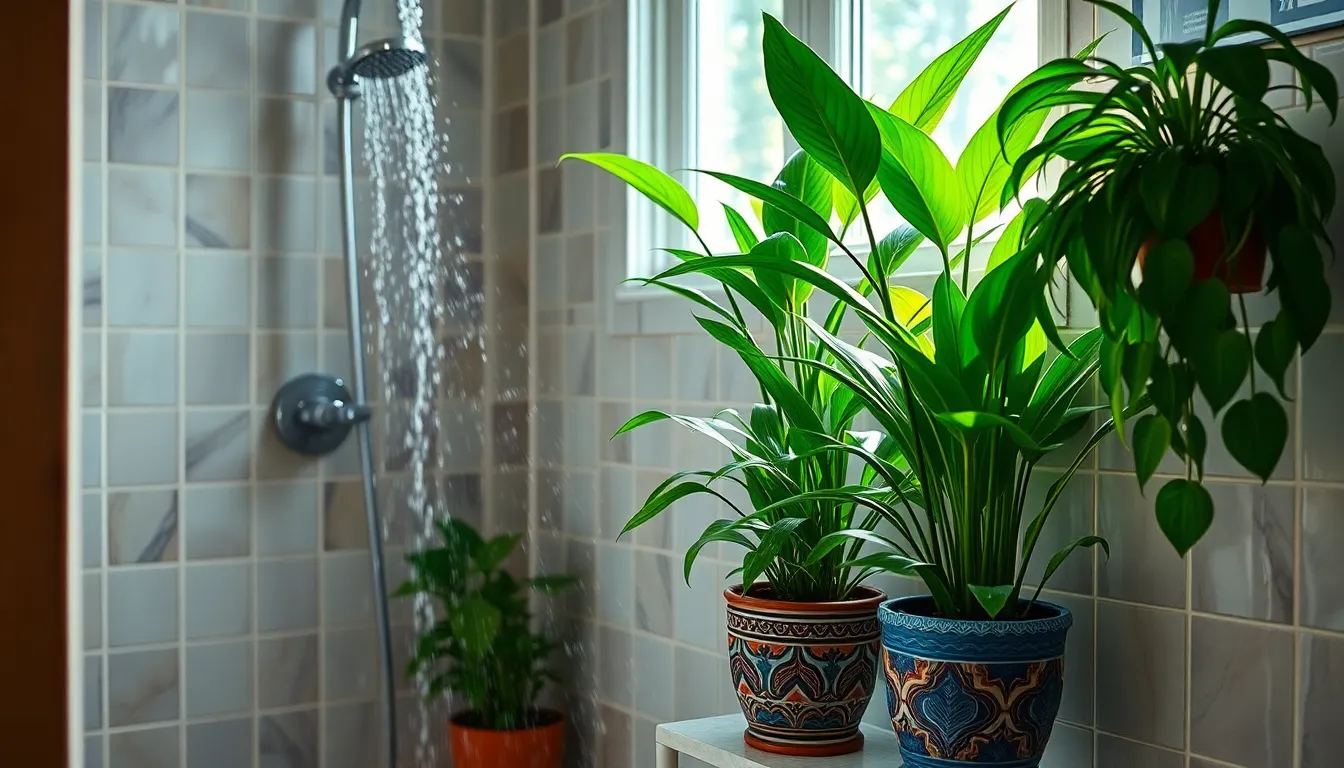
Even with proper care, shower plants can develop issues that require our attention. Let’s explore the most common problems and their answers to keep our bathroom greenery thriving.
Dealing with Overwatering and Root Rot
Overwatering becomes the leading cause of plant failure in shower environments. Plants don’t like “wet feet” since prolonged waterlogged roots can cause root rot. We need to ensure pots have good drainage holes and can dry out between waterings, even in humid shower environments.
Recognizing early signs helps us prevent serious damage. Musty odors from soil, black or brown mushy roots, and yellowing leaves signal overwatering problems. We should check drainage holes regularly to confirm they’re not blocked by soil or debris.
Choosing proper containers makes all the difference. We must avoid stagnant water accumulation by using well-draining soil or appropriate containers with adequate drainage systems. Terra cotta pots work exceptionally well since they’re porous and allow excess moisture to evaporate naturally.
Adjusting watering schedules prevents future issues. We should reduce watering frequency during humid months and increase it when heating systems dry out bathroom air. Testing soil moisture with our finger before watering ensures we’re not adding water to already saturated soil.
Managing Pests in Humid Environments
Humidity creates ideal breeding conditions for various pests. Showers’ humidity can encourage pests like fungus gnats, spider mites, and scale insects to multiply rapidly. We need to carry out preventive measures before infestations become established.
Regular cleaning serves as our first line of defense. Regularly giving plants a gentle shower to rinse away dust and insects is effective for preventing pest buildup. We should avoid high-pressure water that could damage plants and instead use a gentle spray to clean foliage.
Natural cleaning methods work best in shower environments. This natural cleansing helps prevent buildup of pest populations and plant stress without introducing harsh chemicals near our bathing area. We can add a few drops of mild dish soap to spray bottles for enhanced cleaning power.
Monitoring plants weekly catches problems early. We should inspect leaf undersides, stems, and soil surfaces for signs of pest activity. Early detection allows us to treat infestations before they spread to other plants in our shower garden.
Addressing Leaf Yellowing and Dropping
Multiple factors contribute to leaf discoloration in shower plants. Yellowing or dropping leaves can result from overwatering, poor drainage, or insufficient light in showers. We need to evaluate each potential cause systematically to identify the root problem.
Light assessment reveals common issues. We should evaluate the plant’s light exposure since some plants tolerate low light, but most need indirect bright light for healthy growth. Moving plants closer to windows or adding grow lights often resolves yellowing problems.
Drainage evaluation prevents ongoing issues. We must adjust watering schedules to avoid excess moisture and ensure containers have proper drainage systems. Checking that drainage holes aren’t blocked helps prevent water from pooling around roots.
Prompt leaf removal encourages new growth. We should remove damaged leaves to encourage new growth and prevent potential disease spread. Clean pruning shears with rubbing alcohol between cuts to avoid transferring problems between plants.
Environmental adjustments restore plant health. We can improve air circulation around plants and adjust humidity levels if they’re excessively high. Proper spacing between plants prevents overcrowding that can lead to poor air circulation and increased disease risk.
Budget-Friendly Ways to Start Your Shower Garden
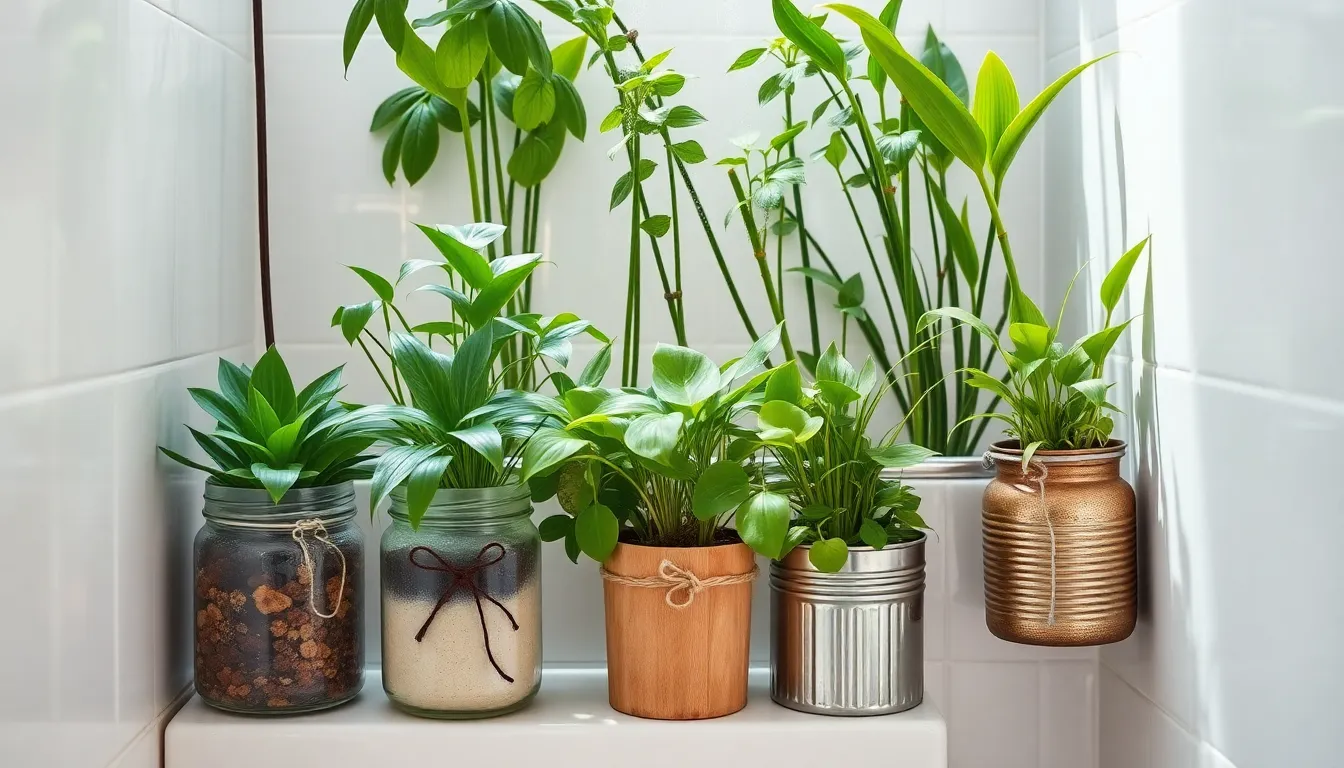
Creating our dream shower garden doesn’t require a hefty investment. Smart strategies can help us build a thriving humid sanctuary without very costly.
Propagating Plants from Existing Houseplants
Spider plants offer the easiest route to free shower greenery since they naturally develop baby plantlets on their shoots that we can simply repot. Pothos cuttings root remarkably fast in water, allowing us to create multiple plants from a single parent specimen within weeks. Philodendrons propagate through the same cutting method, making them perfect candidates for expanding our collection without purchasing new plants.
Tradescantia varieties multiply rapidly through simple stem cuttings placed directly in moist soil or water until roots develop. Air plants produce offshoots called pups that we can gently separate once they reach one third the size of the parent plant. These propagation methods let us transform one houseplant into several shower specimens, dramatically reducing our startup costs while building a diverse collection.
Shopping for Affordable Plant Options
Budget conscious shoppers can find excellent shower plants at local garden centers and online retailers for minimal investment. Spider plants typically cost under $10 and thrive in the humid conditions our showers provide. Lucky bamboo sells for just a few dollars and requires only water changes to flourish in bathroom environments.
Pothos plants offer exceptional value since they grow quickly and adapt to various lighting conditions we encounter in shower spaces. Air plants eliminate soil costs entirely while tolerating the moisture levels that naturally occur during our daily routines. Tradescantia varieties remain among the most affordable options, often available for under $5 while providing trailing beauty that cascades beautifully from elevated positions.
| Plant Type | Average Cost | Key Benefits |
|---|---|---|
| Spider Plant | $5-$10 | Easy propagation, moisture tolerant |
| Lucky Bamboo | $3-$8 | Water only requirements, low maintenance |
| Pothos | $6-$12 | Fast growing, adaptable lighting |
| Air Plants | $4-$15 | No soil needed, humidity loving |
| Tradescantia | $3-$7 | Affordable, beautiful trailing habit |
DIY Answers for Planters and Accessories
Mason jars create perfect waterproof containers for our propagated cuttings while adding rustic charm to modern bathroom designs. Repurposed tin cans work excellently for small plants when we drill drainage holes and apply waterproof paint or decorative finishes. Plastic yogurt containers provide lightweight, moisture resistant homes for our air plants when we add ventilation holes around the sides.
Staghorn ferns mount beautifully on reclaimed wood boards using sphagnum moss and wire, creating living wall art that costs significantly less than store bought installations. Hanging macrame holders crafted from cotton rope offer stylish displays for trailing species like pothos while utilizing vertical space efficiently. Wire baskets lined with coconut fiber provide excellent drainage for larger specimens, and we can customize their appearance with spray paint or decorative wrapping.
Wooden ladder shelves constructed from basic lumber create multiple plant display levels while maintaining the natural aesthetic our shower gardens deserve. PVC pipe systems work wonderfully for creating custom hanging arrangements that accommodate multiple plants at varying heights throughout our shower space.
Conclusion
Creating your dream shower garden doesn’t have to be overwhelming or expensive. We’ve shown you that with the right plant choices strategic placement and proper care routines you can transform any bathroom into a refreshing wellness retreat.
Remember that starting small is perfectly fine – even a single pothos or spider plant can make a important difference in your shower’s atmosphere. As you gain confidence you can expand your collection and experiment with different design themes that match your personal style.
The key to success lies in understanding your exact bathroom conditions and choosing plants accordingly. Whether you’re dealing with low light high humidity or limited space there’s always a solution that works for your unique situation. Your shower garden journey starts with that first plant – so why not begin today?
Frequently Asked Questions
What are the main benefits of adding plants to my shower?
Adding plants to your shower improves air quality by filtering toxins, regulates humidity levels, and creates a calming spa-like atmosphere. Plants like spider plants and peace lilies purify the air, while Boston ferns and aloe vera help control moisture. The greenery also reduces stress and promotes relaxation, transforming your bathroom into a natural wellness retreat.
Which plants work best in high-humidity shower environments?
Tropical plants thrive in shower environments due to their love of humidity. Top choices include pothos, philodendron, calathea, spider plants, and peace lilies. For windowless bathrooms, consider low-light tolerant species like English ivy and snake plants. These varieties adapt well to the moist conditions and can flourish in your shower space.
How do I safely display plants in my shower without creating hazards?
Ensure all mounting hardware is secure and waterproof to prevent falls. Use non-slip surfaces around plant areas and choose non-toxic plants to protect family health. Install proper drainage systems to prevent water damage and mold growth. Consider hanging planters or waterproof corner shelves for safe, accessible plant placement in wet environments.
What type of containers should I use for shower plants?
Choose waterproof and rust-resistant materials like ceramic, stainless steel, aluminum, or high-quality plastic. Glass containers work well but ensure they’re tempered for safety. Avoid materials that can rust or deteriorate in humid conditions. Consider decorative vessels that match your bathroom decor while providing proper drainage for plant health.
How often should I water plants in my shower?
Shower plants typically need less frequent watering due to the naturally humid environment. Check soil moisture weekly and water only when the top inch feels dry. Use filtered water to avoid chemical damage from tap water. Ensure containers have proper drainage to prevent root rot, which is common in overly moist conditions.
Can I grow plants in a windowless bathroom?
Yes, many plants can thrive in windowless bathrooms. Choose low-light tolerant species like spider plants, pothos, English ivy, and snake plants. Consider installing LED grow lights to supplement natural light. These plants adapt well to artificial lighting and can still benefit from the humidity typically found in bathroom environments.
How do I prevent pests in my shower plants?
Maintain regular cleaning routines and inspect plants weekly for early signs of pests. Ensure proper air circulation and avoid overwatering, which attracts insects. Clean leaves regularly to remove potential pest habitats. If pests appear, use gentle, bathroom-safe treatments and consider quarantining affected plants until the issue resolves.
What’s the most budget-friendly way to start a shower garden?
Begin by propagating plants from existing houseplants like spider plants and pothos, which root easily in water. Shop at local garden centers for affordable options like lucky bamboo and tradescantia. Create DIY planters using mason jars, tin cans, or repurposed containers. Start small with 2-3 plants and expand gradually as your confidence grows.
How do I create different design themes with shower plants?
For a tropical rainforest theme, use moisture-loving ferns and orchids. Create a minimalist zen garden with simple plants like lucky bamboo and air plants. For a bohemian jungle look, mix various plants like spider plants and peace lilies at different heights. Match your plant selection and container choices to your desired aesthetic theme.
What maintenance schedule should I follow for shower plants?
Weekly: Rotate plants for even humidity exposure, check soil moisture, and inspect for stress signs. Monthly: Deep clean leaves, fertilize lightly, and prune as needed. Seasonally: Adjust watering schedules based on growth cycles and consider plant rotation. Always use filtered water and ensure proper drainage to maintain healthy plants year-round.

